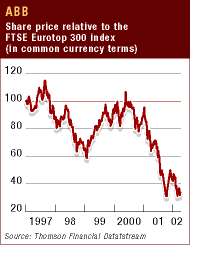

|
ABB's Credit Facility by Prof. Ian H. Giddy, New York University |
 ABB to activate
$3bn credit facility ABB to activate
$3bn credit facility
ABB, the heavily indebted Swiss-Swedish engineering giant, has underlined its growing problems in tapping the short-term money markets by activating a $3bn credit line, which would be used to pay back short-term commercial paper which the group can no longer roll over. The group, which employs 157,000 staff in more than 100 countries, is also seeking the help of its bankers to "enhance the flexibility" of the $3bn one-year facility which was established last December by Credit Suisse First Boston and Citigroup ABB's decision to start drawing down on the $3bn credit facility, comes only a week after it publicly acknowledged that it was facing funding "bottlenecks" in the commercial paper market. Its borrowings in that market jumped from $1.9bn to $3.3bn last year. Nearly half of ABB's $9.8bn of debt, excluding operating leases, falls due this year. Until now ABB has relied heavily on the commercial paper market to cover any funding short-falls. But ABB, in common with some other companies, has been effectively shut out of the commercial paper market in recent weeks as investors have become increasingly nervous about its stretched financial ratios and its inability to cap its unquantified exposure to growing US asbestos insurance claims. ABB is also suffering from the more aggressive approach being taken by the credit rating agencies. They have been heavily criticised for not giving more advance warning of the buildup in problems which led to the collapse of Enron, the US energy giant. Last week, Moody's, the US credit rating agency, lowered ABB's short-term debt rating from Prime 1 to Prime 2 partly because of ABB's dependence on "confidence sensitive funding sources", such as the commercial paper market. By contrast, Standard & Poor's, a rival rating agency, said it saw no reason to lower ABB's rating because it had "significant alternative funding sources" available to compensate for any "bottlenecks" in the commercial paper market. ABB borrows money through five separate commercial paper programmes with a theoretical upper limit of $6.6bn. However, Moody's decision to lower ABB's long-term debt rating from A2 to A3, and maintain its negative outlook, has reduced ABB's financial flexibility. This is because the banks have the right to terminate the new $3bn credit facility if ABB's Moody's rating falls below its current A3 level. Peter Voser, ABB's new chief financial officer, said that ABB would use the $3bn of cash to pay back commercial paper as it falls due and add $1bn to its cash reserves. Mr Voser said the $3bn facility means that ABB would have more than enough cash available under foreseeable circumstances as the group lessens its reliance on the present volatile short-term capital markets. By William Hall
Assignment: What were ABB's alternatives? Assess the choices
made by the company. Is its debt "excessively shrt term?" For the future,
can ABB rely on its banking relationships?
|